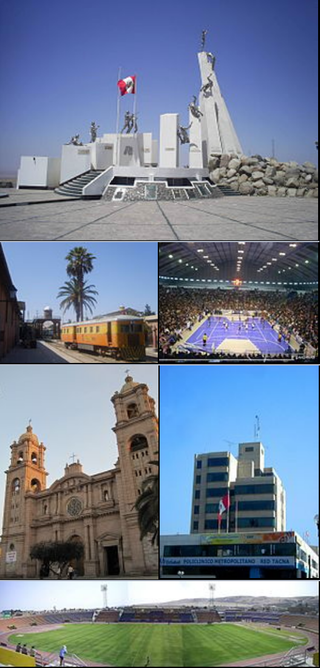
Tacna, officially known as San Pedro de Tacna, is a city in southern Peru and the regional capital of the Tacna Region. A very commercially active city, it is located only 35 km (22 mi) north of the border with Arica y Parinacota Region from Chile, inland from the Pacific Ocean and in the valley of the Caplina River. It is Peru's tenth most populous city.

Tacna is the southernmost department and region in Peru. The Chilean Army occupied the present-day Tacna Department during the War of the Pacific from 1885 until 1929 when it was reincorporated into Peru.

The Peru–Bolivian Confederation was a short-lived state that existed in South America between 1836 and 1839. The country was a loose confederation made up of three states: North Peru and South Peru—states that arose from the division of the Peruvian Republic due to the civil wars of 1834 and 1835 to 1836—as well as the Bolivian State.
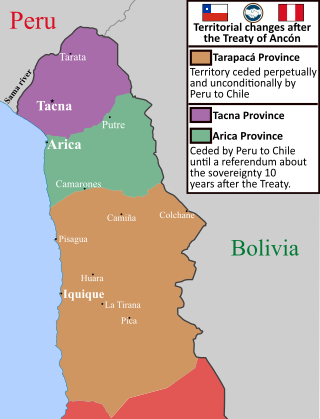
The Treaty of Ancón was a peace treaty signed by Chile and Peru on 20 October 1883, in Ancón, near Lima. It was intended to settle the two nations' remaining territorial differences at the conclusion of their involvement in the War of the Pacific and to stabilise post-bellum relations between them.

Tacna is the largest of four provinces in the Department of Tacna in southern Peru located on the border with Chile and Bolivia. Its capital is Tacna.
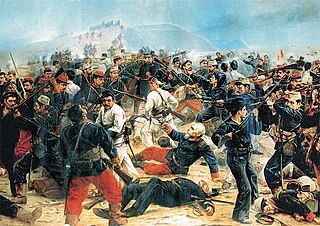
The Battle of Arica, also known as Assault and Capture of Cape Arica, was a battle in the War of the Pacific. It was fought on 7 June 1880, between the forces of Chile and Peru.
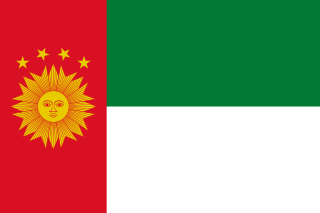
The Republic of South Peru was one of the three constituent Republics of the short-lived Peru–Bolivian Confederation of 1836–39.

Jorge Alfredo Basadre Grohmann was a Peruvian historian known for his extensive publications about the independent history of his country. He served during two different administrations as Minister of Education and was also director of the Peruvian National Library.

The Battle of Tacna, also known as the Battle of the Peak of the Alliance, effectively destroyed the Peru-Bolivian alliance against Chile, forged by a secret treaty signed in 1873. On 26 May 1880, the Chilean Northern Operations Army led by General Manuel Baquedano González, conclusively defeated the combined armies of Peru and Bolivia commanded by Bolivian President, General Narciso Campero. The battle took place at the Inti Urqu (Intiorko) hill plateau, a few miles north of the Peruvian city of Tacna. As a result, Bolivia was knocked out of the war, leaving Peru to fight the rest of the war alone. Also, this victory consolidated the Chilean domain over the Tarapacá Department. The territory was definitively annexed to Chile after the signing of the Tratado de Ancón, in 1884, which ended the war. Tacna itself remained under Chilean control until 1929.
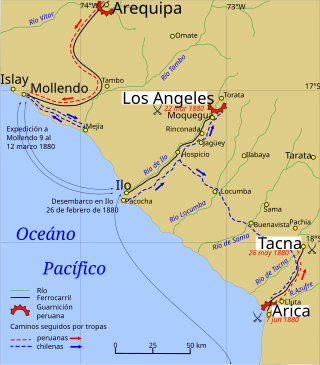
The Tacna and Arica campaign is known as the stage of the War of the Pacific after the Chilean conquest of the Peruvian department of Tarapacá, ending with Chilean domination of the Moquegua department in southern Peru. During this campaign Bolivia retired from the war after the Battle of Tacna, and Peru lost the port of Arica. Also, Manuel Baquedano assumed command as the new Commander in Chief of the Chilean Army, and the Allied Presidents were thrown out of office and replaced by Nicolas de Pierola in Peru and General Narciso Campero in Bolivia.
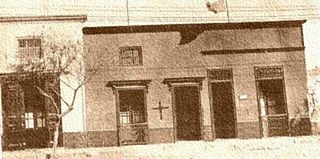
The Chilenization of Tacna, Arica, and Tarapacá was a process of forced transculturation or acculturation in the areas which were invaded and incorporated by Chile since the War of the Pacific (1879–1883). The aim of the Chilenization was to create a dominance of Chilean traditions and culture in that region, in preference to those of the Peruvian population. The British desire to reunite all saltpeter mines under one political administration was also a major factor that influenced the outcome of the war.

The Peruvian-Bolivian War was a warlike confrontation between Peru and Bolivia in the years 1841 and 1842.

The Alto de la Alianza Museum is a war museum located at the Alto de la Alianza, near Tacna, in southern Peru. It was inaugurated on May 26, 1982.

Intiorko Hill is located at Ciudad Nueva District in Tacna Department, located in southern Peru. At 780 metres above sea level, the stone used for the construction of the Tacna Cathedral, the Parabolic Arch and the Tacna Prefecture comes from the hill.

The Crypt of Heroes is a war monument located at Intiorko Hill, Tacna, Peru. Originally inaugurated by the Chilean administration in 1901 and rededicated in 1930 by the Peruvian government, the monument is currently partially destroyed.

La respuesta, also known as La respuesta de Bolognesi, is an 1891 oil painting by Peruvian painter Juan Lepiani. It forms part of the collection of the Combatants of the Morro de Arica Museum.

El último cartucho is an 1899 oil painting by Peruvian painter Juan Lepiani. It forms part of the collection of the Combatants of the Morro de Arica Museum.

The Combatants of the Morro de Arica Museum, also known as the Casa de Bolognesi, is a house museum dedicated to the War of the Pacific and its battle of Arica, located at the birthplace of Francisco Bolognesi, in the historic centre of Lima, Peru.

Juan José de la Cruz Salvo y Poblete was a Chilean soldier who fought in the War of the Pacific as a Sergeant major. He is best known for being the envoy sent by the Chilean Army to the headquarters of Francisco Bolognesi's garrison in Arica to request his surrender after the allied defeat at the Battle of Tacna, to which Bolognesi replied by saying he would "fight until the last cartridge is spent".
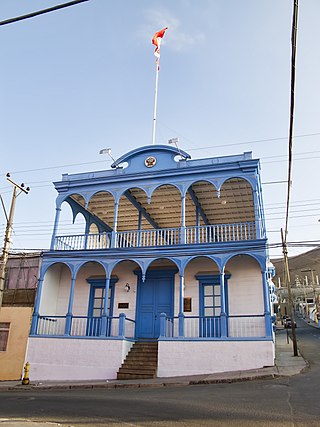
The Casa Bolognesi, also known as the Casa de la Respuesta, is a historical building owned by the Peruvian State located in Arica, Chile. It is the site of a meeting that preceded the Battle of Arica during the War of the Pacific.
























